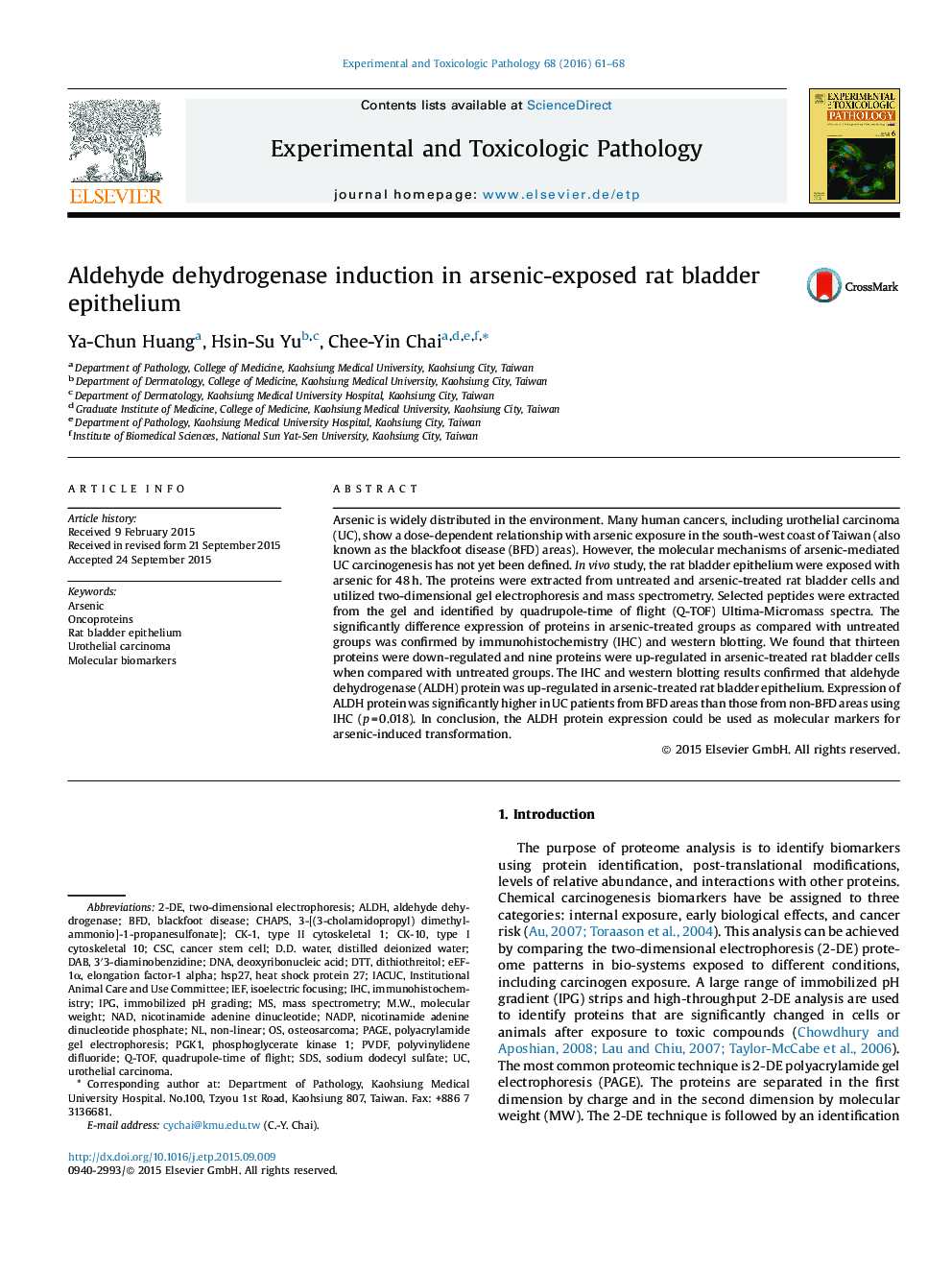| کد مقاله | کد نشریه | سال انتشار | مقاله انگلیسی | نسخه تمام متن |
|---|---|---|---|---|
| 5817079 | 1116470 | 2016 | 8 صفحه PDF | دانلود رایگان |
عنوان انگلیسی مقاله ISI
Aldehyde dehydrogenase induction in arsenic-exposed rat bladder epithelium
ترجمه فارسی عنوان
القائی الیدید دهیدروژناز در اپیتلیوم مثانه موش های در معرض آرسنیک
دانلود مقاله + سفارش ترجمه
دانلود مقاله ISI انگلیسی
رایگان برای ایرانیان
کلمات کلیدی
ALDHM.W.Elongation factor-1 alphaOncoproteinsCK-1BFDHSP27PGK13′3-diaminobenzidinePAGEIEFQ-TOF2-DEDTTNADPCSCPVDFIACUCDABSDSDNA - DNA یا اسید دزوکسی ریبونوکلئیکIPG - GPAdistilled deionized water - آب تخلیه شده تقطیر شدهArsenic - آرسنیکaldehyde dehydrogenase - آلدئید دهیدروژنازOsteosarcoma - استئوسارکوماdeoxyribonucleic acid - اسید deoxyribonucleicTwo-dimensional electrophoresis - الکتروفورز دو بعدیpolyacrylamide gel electrophoresis - الکتروفورز ژل پلی آکریل آمیدIHC - ایمونوهیستوشیمیImmunohistochemistry - ایمونوهیستوشیمیblackfoot disease - بیماری قلبیMolecular biomarkers - بیومارکرهای مولکولیisoelectric focusing - تمرکز ذره ای الکتریکیpolyvinylidene difluoride - دی فلوئورید پلی وینیلیدینdithiothreitol - دیتیوتریتولQuadrupole-time of flight - زمان چهارگانه پروازInstitutional Animal Care and Use Committee - سازمان مراقبت و مراقبت از حیواناتsodium dodecyl sulfate - سدیم دودسیل سولفاتurothelial carcinoma - سرطان پروستاتcancer stem cell - سلولهای بنیادی سرطانیMass spectrometry - طیف سنجی جرمیNon-linear - غیر خطیPhosphoglycerate kinase 1 - فسفوگلیسرات کیناز 1NAD - نادانnicotinamide adenine dinucleotide - نیکوتین آمید adenine dinucleotidenicotinamide adenine dinucleotide phosphate - نیکوتین آمید adenine dinucleotide phosphateMolecular weight - وزن مولکولیHeat shock protein 27 - پروتئین شوک حرارت 27CHAPS - چاپس
موضوعات مرتبط
علوم زیستی و بیوفناوری
علوم کشاورزی و بیولوژیک
علوم دامی و جانورشناسی
چکیده انگلیسی
Arsenic is widely distributed in the environment. Many human cancers, including urothelial carcinoma (UC), show a dose-dependent relationship with arsenic exposure in the south-west coast of Taiwan (also known as the blackfoot disease (BFD) areas). However, the molecular mechanisms of arsenic-mediated UC carcinogenesis has not yet been defined. In vivo study, the rat bladder epithelium were exposed with arsenic for 48 h. The proteins were extracted from untreated and arsenic-treated rat bladder cells and utilized two-dimensional gel electrophoresis and mass spectrometry. Selected peptides were extracted from the gel and identified by quadrupole-time of flight (Q-TOF) Ultima-Micromass spectra. The significantly difference expression of proteins in arsenic-treated groups as compared with untreated groups was confirmed by immunohistochemistry (IHC) and western blotting. We found that thirteen proteins were down-regulated and nine proteins were up-regulated in arsenic-treated rat bladder cells when compared with untreated groups. The IHC and western blotting results confirmed that aldehyde dehydrogenase (ALDH) protein was up-regulated in arsenic-treated rat bladder epithelium. Expression of ALDH protein was significantly higher in UC patients from BFD areas than those from non-BFD areas using IHC (p = 0.018). In conclusion, the ALDH protein expression could be used as molecular markers for arsenic-induced transformation.
ناشر
Database: Elsevier - ScienceDirect (ساینس دایرکت)
Journal: Experimental and Toxicologic Pathology - Volume 68, Issue 1, January 2016, Pages 61-68
Journal: Experimental and Toxicologic Pathology - Volume 68, Issue 1, January 2016, Pages 61-68
نویسندگان
Ya-Chun Huang, Hsin-Su Yu, Chee-Yin Chai,
